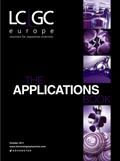Extraction of Testosterone and Other Steroid Hormones from Human Plasma Using ISOLUTE SLE+ 96-Well Plates
Biotage Application Note
This application note describes an optimized and effective supported liquid extraction protocol for the sample preparation of a range of steroid hormones, including testosterone, from human plasma using ISOLUTE SLE+. Supported liquid extraction is an efficient and cost effective alternative to traditional liquid-liquid extraction (LLE) for bioanalytical sample preparation, providing high analyte recoveries, no emulsion formation and significantly reduced sample preparation time. This simplified extraction method has significant analyte recoveries ranging from 90 to 107% with LOQs as low as 500 pg/mL.
Extraction Conditions
This application note outlines the procedure using the ISOLUTE SLE+ 200 Supported Liquid Extraction plate (part number 820-0200-P01) optimized for a 200 µL pretreated human plasma sample volume (other formats are available). Method parameters and dilution factors have been optimized to maximize recoveries and minimize ion suppression.
Sample pre-treatment: Dilute human plasma (100 µL) 1:1 with HPLC-grade water (100 µL).
Sample load: Load pre-treated sample (200 µL) to plate followed by a pulse of vacuum to initiate flow and leave for five minutes.
Analyte elution: Elute with dichloromethane (1 mL) directly in to a deep well collection plate (1215203). Leave to flow under gravity for 5 min then apply short pulse of vacuum.
Post extraction: Evaporate to dryness at ambient temperature and reconstitute in 50% methanol (aq) (100 µL). Vortex samples to ensure full reconstitution.
Additional information: Use of the reconstitution solvent combined with the vortex step addresses any issues that may arise from nonspecific binding of testosterone and other analytes. All samples were processed using Biotage VacMaster-96 sample processing manifold and evaporated to dryness on a SPE Dry 96 Dual.
Analytical Conditions
Instrument: Waters Acquity UPLC interfaced to a Quattro Premier XE triple quadrupole MS using electrospray ionization.
Column: Acquity BEH C18 100 × 2.1 mm × 1.7 µ.
Mobile phase: A: 0.1% formic acid (aq)
B: 0.1% formic acid in methanol.
Gradient:
Time (min) %B
Initial 50
0.8 50
4.2 81
4.3 100
5.3 100
5.8 50
6.8 50
Flow-rate: 0.40 mL/min.
Injection: 15 µL (partial loop, needle overfill).
Sample temp: 20 °C.
Column temp: 40 °C.
Source temp: 150 °C.
Desolvation temp: 450 °C.
Results
Sample recoveries are >90% for all analytes with RSDs below 10%. Table 1 shows the range of LOQs recorded for each individual analyte.

Table 1: Steroid LOQs recorded using SLE+ extraction protocol.
Conclusions
This method demonstrates that an extensive suite of steroids can be extracted under the same conditions using a very simple supported liquid extraction protocol. Non-chlorinated elution solvents were also evaluated and although levels were not fully optimized it should be possible to substitute ethyl or butyl acetate for dichloromethane with only a slight reduction in performance.
References
1. A. Senior, L. Williams et al., Application Note AN 740 (available from www.biotage.com/applications).
Biotage AB
Kungsgatan 76, SE-753, 18, Uppsala, Sweden
tel: +46 18 56 59 00 fax: +46 18 59 19 22
E-mail: info@biotage.com Website: www.biotage.com

Extracting Estrogenic Hormones Using Rotating Disk and Modified Clays
April 14th 2025University of Caldas and University of Chile researchers extracted estrogenic hormones from wastewater samples using rotating disk sorption extraction. After extraction, the concentrated analytes were measured using liquid chromatography coupled with photodiode array detection (HPLC-PDA).
Silvia Radenkovic on Building Connections in the Scientific Community
April 11th 2025In the second part of our conversation with Silvia Radenkovic, she shares insights into her involvement in scientific organizations and offers advice for young scientists looking to engage more in scientific organizations.
Regulatory Deadlines and Supply Chain Challenges Take Center Stage in Nitrosamine Discussion
April 10th 2025During an LCGC International peer exchange, Aloka Srinivasan, Mayank Bhanti, and Amber Burch discussed the regulatory deadlines and supply chain challenges that come with nitrosamine analysis.



















